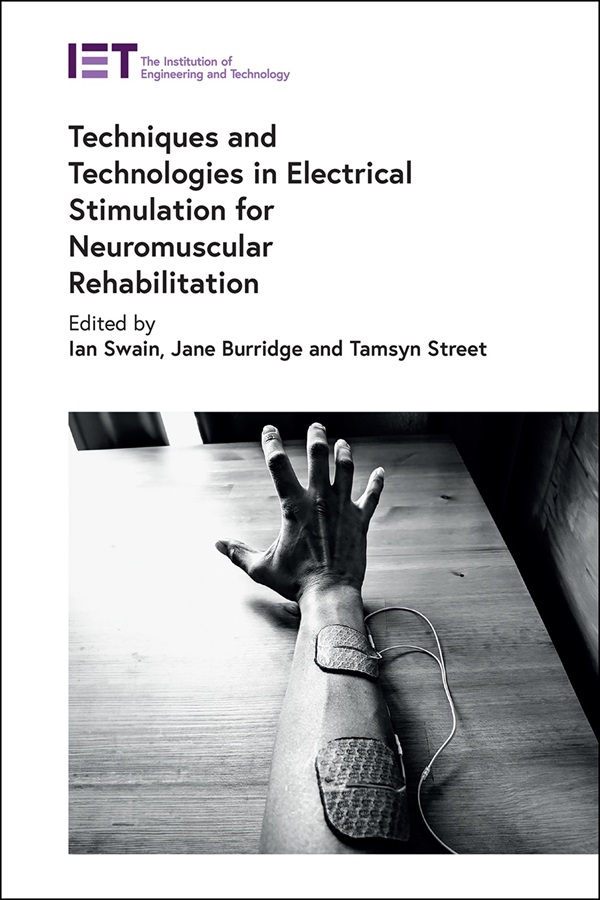- Agricultural Engineering and Technology
- Applied Physics
- Built Environment
- Computing and Networks
- Control, Robotics and Sensors
- Electrical Regulations
- Electromagnetics and Radar
- Energy Engineering
- Healthcare Technologies
- History and Management of Technology
- IET Codes and Guidance
- Manufacturing
- Materials, Circuits and Devices
- Model Forms
- Security
- Telecommunications
- Transportation

Techniques and Technologies in Electrical Stimulation for Neuromuscular Rehabilitation
Edited by Ian Swain, Jane Burridge, Tamsyn Street
In its simplest form, electrical stimulation is the application of electrical impulses to nerves via electrodes placed over the nerve or muscle or implanted within the body. The aim is to evoke a muscle contraction. People may not be able to activate their own muscles sufficiently to execute effective movement due to damage to the nervous system preventing the signals from the brain reaching the muscles, for example, after a stroke or spinal cord injury, or due to disuse, often because of pain. Electrical stimulation can be used to restore or improve impaired function by initiating or complementing muscle activity. Stimulation can be used either to provide exercise and so improve strength and endurance or timed to a physical activity such as walking to improve quality of movement and function.
Over the last twenty-five years electrical stimulation has moved from a research technique to an evidence-based clinical modality. Early applications were limited to the treatment of drop-foot and loss of upper limb function. However, advances in technology, understanding of neural recovery and clinical evidence have opened applications to treat a wide range of conditions, such as pressure sores, bladder, bowel and sexual dysfunction, spasticity and lower motor neuron damage. The reader is taken from the history of therapeutic electrical stimulation, through the physiology that underpins its use, to practical guidance in clinical applications and the regulatory issues that need to be considered in the development of new technologies. It presents the research evidence for each application, reflects on new technologies and applications, such as the use of afferent stimulation to increase central and peripheral neural excitability, and provides practical guidance for clinical use.
Techniques and Technologies in Electrical Stimulation for Neuromuscular Rehabilitation brings together experts from the fields of neuroscience, biomedical engineering and clinical research and practice. The non-technical style enables it to bridge the gap between disciplines, making it essential reading for clinicians, researchers, engineers and industrial developers specialising in electrical stimulation technologies. It aims to improve patient access to evidence-based interventions.
About the Editors
Ian Swain is a professor of clinical engineering at Bournemouth University, UK. Ian helped established the National Clinical FES (Functional Electrical Stimulation) Centre in Salisbury and took several products they designed to market. Ian was clinical director of OML until 2017 and personally assessed over 3500 patients. Ian has served as a board member of the International Functional Electrical Stimulation Society (2002-2005). He has 7 patents and has written over 200 papers in rehabilitation engineering.
Jane Burridge is a professor of restorative neuroscience at the University of Southampton where she leads the Neurorehabilitation Research Group. Drawing from her research, she designs and evaluates rehabilitation technologies that will aid recovery following central nervous system lesions such as stroke or spinal cord injury. She has written over 350 journal articles and conference papers. She is a former President of IFESS (2010).
Tamsyn Street is an interdisciplinary research fellow at Salisbury NHS Foundation Trust with a background in motor neurorehabilitation. She is currently an executive board member of the IFESS. Her research interests include the use of electrical stimulation technologies for improving motor neurorehabilitation, neurogenic bowel, bladder, sexual functioning and respiratory functioning and exploring the underlying mechanisms of electrical stimulation to optimise outcomes for patients.
Publication Year: 2024
Pages: 572
ISBN-13: 978-1-83953-876-6
Format: HBK
